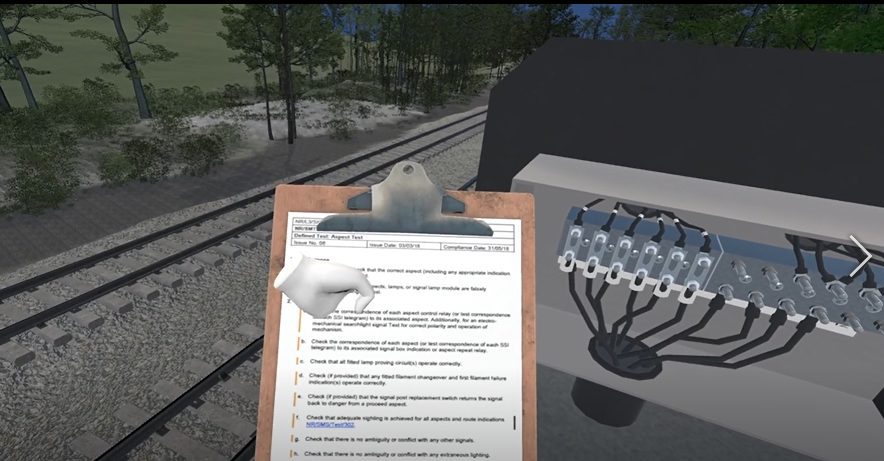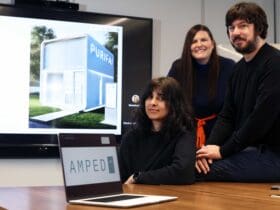Having witnessed one of the worst train crashes in British history, Paul Martin was motivated to ensure that engineers would be trained so that this would never happen again.
So, after a career working in rail engineering, he went into partnership with his wife Pam, an experience trainer and assessor, to develop a system which would give other railway engineers the skills needed to guarantee rail safety.
Having already developed a mobile unit, which could travel around the country to give engineers hands-on training on simulated systems used on the railways – among them a life-size mock-up of a set of railway points – Paul and Pam decided to expand their business, PM Training and Assessing, to take in virtual reality (VR).
And now, with the help of the Centre of Excellence in Mobile and Emerging Technologies (CEMET), which is based at the University of South Wales (USW), a VR training system has been developed to give engineers an understanding of what can go wrong if vital railway systems are incorrectly tested, and also see an example of the news headlines that could follow a major rail disaster.
Paul joined the rail industry in the 1980s when he was just 16, starting out as an apprentice rail engineer and working in the sector until he was made redundant in 2018. Meanwhile, Paul’s wife Pam was working in the training business, specialising in training and assessing.
When the couple moved to Wales, Pam started her own business and, following Paul’s redundancy, they started working together to offer technical training to the railway industry.
“What we found, however, was that our location in Crickhowell wasn’t ideal. We weren’t near a railway or a station,” Pam said.
“So, what we decided to do was to turn the process on its head and make a mobile technical classroom, which has all the equipment in it that we can take to the client and deliver the training there for them.
“We also wanted to be at the front edge of training. Railway training is very traditional – you go on a course, sit in front of a PowerPoint, then you a have a go with the equipment. We wanted to take it a bit further and be a bit more creative, hence the signalling system mock-up and real-life points systems.”
Having delivered training across the UK in the mobile unit, including for a number of the industry’s major players, including Network Rail, the new Crossrail project, Siemens and Cleshar, which provides services to Transport for London. Pam and Paul looked to develop the training further after they identified gaps in what was on offer.
“The students were doing the classroom learning and were able to use the practical equipment, but we couldn’t take them out onto the live railway to get experience there, and see some of the consequences if things went wrong,” Paul said.
“I was an apprentice when the Clapham Junction accident happened in 1988, when 35 people were killed, I was on site, and I never want to see anything like that ever happen again, or anyone to go through that.
“If you can show people the consequences of their actions, in a training environment, then that’s a way of shocking them into realising what can happen if they get things wrong.”
With this experience in mind, Paul contacted CEMET for support in developing a virtual environment, where the trainees can see what could happen if they didn’t successfully complete the training.
“In the mobile unit we can show them what happens trackside, and what electronics are inside the trackside cases that control the trains and the signals,” Paul said.
“CEMET created the next step – a virtual environment. There’s a signal in there, which they can climb up, and see the back of the signal and all the wiring, they can make changes to the wires, and follow the tests they are required to do in the mobile classroom.
“In the mobile classroom, however, you can’t simulate the impact of missing a test out, whereas what CEMET has done is allowed us to show that – they will see the consequences of that with a simulated train accident, and then the VR headset zooms in on the headlines following a railway accident, with sombre music. It’s there as a way of showing them what will follow if they don’t do their jobs right.”
According to Paul, CEMET’s support has been key in helping the business develop.
“CEMET has been fantastic all the way through, so supportive and brilliant,” he said.
“They got on board with the technical side from the start, understood how it needed to work, and ensured that the VR showed all it needed to show, and to be as hard-hitting as possible at the end. What they produced was incredible.”
Clayton Jones, Programme Manager at CEMET, said: “Working with Paul and Pam at PM Training and Assessing is what CEMET is all about, helping small businesses which need specialist tech support, but may not have the funding available, get their ideas off the ground.
“Paul and Pam came to us with a specific idea of what they wanted, and worked closely with our VR specialists to turn that vision into a reality.
“We are delighted that we’ve been able to help another small business to develop, while supporting its efforts to make the UK’s railways even safer.”
CEMET, which is based at USW, was launched in March 2017 with £4.2m of backing from the European Regional Development Fund (ERDF) through the Welsh Government. It originally offered support to companies in the Valleys, West Wales, and North Wales. The new £2.4m CEMET East project was launched in 2019, with £1.2m of funding from the Welsh European Funding Office (WEFO). This means that the pan-Wales CEMET is now a £8.9m project, with £5.5m of ERDF funding, and will run until March 2023.








Leave a Reply
View Comments